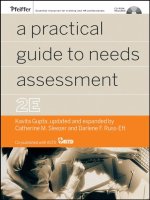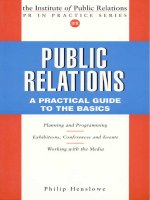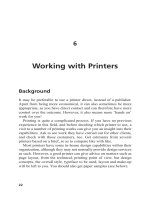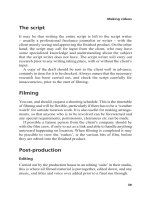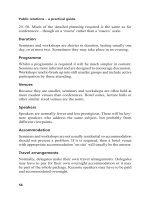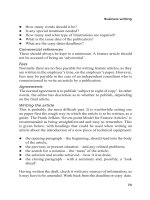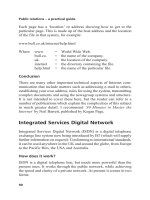Online Public Relations A Practical Guide to Developing an Online Strategy in the World of Social Media PR in Practice by David Phillips and Philip Young_6 doc
Bạn đang xem bản rút gọn của tài liệu. Xem và tải ngay bản đầy đủ của tài liệu tại đây (140.95 KB, 17 trang )
Public relations – a practical guide
90
Each page has a location or address showing how to get to the
particular page. This is made up of the host address and the location
of the file in that system, for example:
www.bull.co.uk/internet/help.html
Where www = World Wide Web.
bull.co. = the name of the company.
uk. = the location of the company.
internet = the directory containing the file.
help.html = the name of the particular file.
Conclusion
There are many other important technical aspects of Internet com-
munication that include matters such as addressing e-mail to others,
establishing your own address, rules for using the system, transmitting
complex documents and using the newsgroup systems and structure.
It is not intended to cover these here, but the reader can refer to a
number of publications which explain the complexities of this subject
in much greater detail. I recommend 30 Minutes to Master the
Internet by Neil Barrett, published by Kogan Page.
Integrated Services Digital Network
Integrated Services Digital Network (ISDN) is a digital telephone
exchange line system now being introduced by BT (which will supply
further information on request). Conforming to international standards,
it can be used anywhere in the UK and around the globe, from Europe
to the Pacific Rim, the USA and Australia.
How does it work?
ISDN is a digital telephone line, but much more powerful than the
present ones. It works through the public network, while achieving
the speed and clarity of a private network. At present it comes in two
forms:
319(17).p65 13/06/00, 12:5290
91
New developments in technology
1. ISDN 2 the Basic Rate Service, designed to meet the needs of
smaller businesses, or parts of larger organizations.
2. ISDN 30 the Primary Rate Service. This can meet requirements
of both large and small companies or locations.
Using ISDN
ISDN will allow you to send and receive any amount of information
in a variety of forms, such as voice, data, images and videos. It can
be used to make phone calls, send large amounts of data around the
country, rush photographs and artwork to the advertising agency or
hold video conferences. As it is a public network service you only
pay for what you use and you achieve greater cost savings as it allows
for fast call set-up and then takes a fraction of the time to send the
information.
Several large businesses in the UK, such as Bass Brewers, have
installed this system, enabling them to gain a competitive edge in the
brewing industry, halving packaging lead times with their design data
delivery and for desktop conferencing facilities.
Digital photography and scanning
Digital photography and scanning are two more aspects of information
technology that are changing rapidly. They will be of particular interest
to both photographers and computer users. Although at present in
their infancy, they are seen as being a great step forward in the uses
and application of photography generally and will, no doubt, have an
impact on the way public relations works in the future.
The benefits of these new systems include greater control over
image quality, reduced costs and the elimination of expensive scanning
fees. The AGFA Gevaert Company provides useful Guides to Digital
Photography and Digital Scanning obtainable through photographic
shops.
319(17).p65 13/06/00, 12:5291
Public relations – a practical guide
92
18
Planning and Programming
Why have a programme?
Unless there is a programme for public relations work it will tend to
become muddled, disjointed and little of it will be completed satisfact-
orily; nor can the results of unplanned work be analysed successfully.
A public relations programme is not about short-term, reactive or
haphazard public relations.
Part of the IPR definition of public relations includes the following:
the deliberate, planned and sustained effort to establish and maintain
mutual understanding between an organization and its publics.
The essentials to remember when planning are:
l the deliberate, planned and sustained effort;
l establish and maintain;
l mutual understanding.
These are the concepts. Public relations programmes should be
planned using them as descriptives so as to achieve the best, definitive
results.
319(18).p65 13/06/00, 12:5392
93
Planning and programming
The programme
A programme should be designed to last for a reasonable length of
time, at least 12 months, if not longer. Any such programme is a
complex undertaking, and should cover the strategy for public relations
activity. Thus, the programme is the strategy and, within it, the
individual events or activities are the tactics. When planning public
relations programmes, there are various points to be borne in mind.
The unpredictable
Any programme should be planned well in advance, certainly not less
than about three months. Allowances must always be made for the
unexpected or the unpredictable (otherwise known as Murphys Law).
Often things will happen simultaneously. Never try to operate on a
day-to-day basis.
Flexibility
Build in flexibility and allow for regular reviews at stated intervals.
Also, allow for certain fixed feasts these are events that happen
regularly, eg publishing house journals, annual reports, launches,
exhibitions etc.
Priorities
In order to achieve the best results for the programme, always take
into account the following resources (or lack of them):
l the necessary human resources;
l material resources;
l financial resources.
319(18).p65 13/06/00, 12:5393
Public relations – a practical guide
94
There will inevitably be constraints, and therefore priorities have to
be worked out in advance.
Budgets
In-house public relations departments have to present a costed
programme to management. Similarly, a consultancy making a
presentation to a client must include a detailed programme of the
proposals, supported by a fully calculated budget. This will enable
the client to know exactly what can be expected for the money, and
the consultancy will know how much it can expect to get paid!
Controlling the programme
The best control is to use a simple daily or weekly system. There
may be an existing system that can be adapted quickly and easily.
Below are two examples of methods of control.
Time sheets
These provide a simple check on how much time and human
resource is being spent. They can act as an early warning system
for any overruns that may occur, and can also be used as a bench-
mark for any future work. They also help in calculating fees. A
secretariat can collect and then collate time sheets, keep running totals
and compare them with any target totals.
Job numbers
These are useful for controlling costs by identifying all related invoices
and orders. Job numbers help to isolate and identify items for subse-
quent allocation to cost centres.
319(18).p65 13/06/00, 12:5394
95
Planning and programming
How to plan the programme
To be successful, the plan should be systematic. A good way of
achieving this is to use the six-point method devised by the late
Frank Jefkins, as set out below:
1. appreciation of the situation;
2. definition of objectives;
3. definition of your publics;
4. selection of the media;
5. budgets;
6. assessment of results.
Remember:
l the identified publics must relate to the objectives;
l the media and the techniques used will be the means of com-
municating with the public;
l to consider any budget constraints when drawing up the plan;
they will affect:
the number of objectives;
the identified publics;
availability of the media;
types of media to be used.
The end result of your planning will be the programme or proposi-
tion.
319(18).p65 13/06/00, 12:5395
Public relations – a practical guide
96
19
Assessment and Evaluation
Assessment
At various times in life goals have to be set and objectives met, if
only for the purpose of personal achievement. Some sort of assessment
then has to take place to see if all (or even any) of your objectives
have been met, and whether what had been planned has been effect-
ively carried out.
It will be recalled that in the last chapter, when looking at public
relations programming and planning, one of the key factors in the six
point plan was setting of objectives: We cannot successfully plan
without objectives, and without those objectives we cannot assess
results.
In public relations terms, unless objectives are set and some form
of assessment and subsequent evaluation carried out, it is impossible
to say whether those objectives have been achieved, how effective
that particular programme has been or, for that matter, how successful
any public relations work has been. Without objectives there can be
no assessment, which, along with evaluation, are of paramount import-
ance in public relations work. Assessment and evaluation show how
effective, objective and purposeful a particular piece of work is, or
has been, in achieving the objectives that were set. If management
319(19).p65 13/06/00, 12:5496
97
Assessment and evaluation
knows what it wants from public relations it will expect it to be work
that produces results that can be measured.
Enlightened management, in organizations such as Marks &
Spencer use this sort of measurable public relations as a business
technique. They do not spend a great deal on advertising, but have
good public relations and an excellent reputation.
Evaluation
There are three main ways to evaluate the results of a public relations
programme:
1. observation and experience;
2. feedback and analysis;
3. research.
Observation and experience
This method is probably the crudest and simplest, but it is also the
least expensive form of evaluation. It is not, perhaps, the most scien-
tific method, but can be very effective. It is similar to a military
intelligence-gathering operation, in that it draws on a variety of sources
of raw information and material from which certain conclusions are
then made.
However, it may also be somewhat subjective, in that the analysts
may draw incorrect or biased conclusions based on insufficient
evidence, either qualitative or quantitive. Nevertheless, if other means
are not available, then it should be used. Examples of this method
are:
l A community relations programme. The success or otherwise
of this programme could be measured by monitoring the attitude
of the local media, before, during and after the programme. Also
observe the local community, through conversations, correspond-
ence and even their participation at public events dealing with
matters affecting them.
319(19).p65 13/06/00, 12:5497
Public relations – a practical guide
98
l A recruitment campaign (to raise the standard of the calibre of
staff being recruited). By analysing all the job application forms
for posts in the organization over a given period, a view can be
taken as to whether or not the campaign was effective.
l A media relations campaign. Was it successful? Did it produce
more qualitative as well as quantitative press coverage? By
collating all press cuttings, media tapes and any other coverage,
the success or otherwise of the programme can be measured
and certain conclusions drawn from the results.
Feedback and analysis
Public relations is a two-way process, so it should be listening as
well as telling. Feedback and the subsequent analysis of the information
received, can be a very useful method of assessing the effectiveness
of work carried out.
Again, it is a form of intelligence gathering, or detective work, in
that a mass of raw material has to be collected together in different
forms, sifted through, collated, kept or discarded, and then analysed.
Out of that analysis should emerge a picture that will give an accurate
assessment of the effectiveness of the programme a sort of jigsaw.
Feedback can also be somewhat subjective. There is a danger of
this unless the analysts ensure that they are not being selective over
what they retain perhaps for political reasons. All relevant informa-
tion should be retained for analysis, however insignificant it may
appear. Analysts should take everything into account when assessing
information and in their subsequent analysis again, the detective
work analogy. Feedback will come from a wide variety of sources,
both internal and external, such as:
l complaints;
l ideas and suggestions;
l reports and recommendations;
l newspaper cuttings whether qualitative or quantitative;
l broadcast media monitoring (as above);
l books, articles and features;
l parliamentary and local authority committee reports;
319(19).p65 13/06/00, 12:5498
99
Assessment and evaluation
l minutes and notes of meetings;
l conversations the least accurate but sometimes indicative.
Analysis
The analyst (that is the PRO) then has to examine all the material
collected, analysing and classifying it so that a report can be drawn
up and presented to management.
A source rating, or system of categorization for reliability and
accuracy may be helpful. This system, say ranging from category A
being the most reliable, through to F being the least accurate, or
reliable, may be the most straightforward and appropriate.
In most cases assessment may not require such a complicated or
sophisticated system, but it is better to use a systematic approach rather
than carry out assessments haphazardly.
Based on the results of the analysis, the PRO can then make the
necessary assessment and produce his or her report.
Action
The PRO then has to advise management of the results and what action
should be taken, for example some form of pre-emptive action. The
results of the analysis may have to be acted upon immediately, or
may merely be filed for future reference.
Research
The third (and probably the most objective and scientific) means of
evaluation and assessment in use today is research. Market research
is probably the most-used method in this area of public relations, and
issued to assist in:
l changing attitudes;
l improving awareness;
l altering images.
With the research method of assessment, before any programme is
carried out there has to be some initial research to establish a starting
point. This creates a snapshot of the present position, the base-line
from which to work.
319(19).p65 13/06/00, 12:5499
Public relations – a practical guide
100
Pre-programme research
There are two main ways of conducting this base-line or pre-
programme research: first, by independent primary research; second,
by using an existing omnibus survey with a special questionnaire
insert.
Interim research
Following completion of this market research, objectives can be
identified and drawn up for implementation in the programme. Pro-
gress can be monitored throughout the programme by having interim
surveys at stated intervals if this is thought necessary or appropriate.
They could be helpful if the programme is a long-term one, as they
will indicate whether the programme is targeted correctly, is having
any impact, or is skewed.
Post-programme research
On completion of the programme the follow-up or post-programme
research is carried out. A survey after completion should reveal how
effective the programme has been.
Conclusion
Management can only expect to get properly assessed and evaluated
results if they give support to a properly planned and executed pro-
gramme. Trying to carry out public relations programmes on the cheap
will only end up with unassessable results. In public relations terms
this is both unacceptable and unprofessional.
For further reading on this subject, see Planning and Managing a
Public Relations Campaign, Anne Gregory, published by Kogan Page.
319(19).p65 13/06/00, 12:54100
101
Conclusion
20
Conclusion
The many changes in attitudes that have taken place in our society in
recent years, with an increasing demand for information, the question-
ing of decision making and the increasingly voracious appetite for
more and more detail about everything that happens, all demonstrate
clearly the significant role to be played by public relations and the
need for it to provide this information. These changes, together with
ever-increasing pressure from the media and the public, in almost
every field of activity, also demonstrate the need for effective public
relations, to help in changing attitudes, influencing opinion and creat-
ing awareness in many different ways.
Public relations is not an exact science, but covers all fields of
activity. Its practitioners require a wide range of skills and personal
qualities, including sound judgement, integrity, knowledge, organiza-
tional skills and personality. Armed with these they will have the
ability to communicate, to create knowledge and understanding of
events, issues and even individuals. All are essential in the world today.
To paraphrase Professor Sam Black, there are two worlds in public
relations: one is the practitioner who practises public relations for the
benefit of the client or the employer; the other is the very wide range
of activities which go to make up public relations practice.
It is all the more important, therefore, that all who work in public
relations are not only conversant with all the different activities and
319(20).p65 13/06/00, 12:54101
Public relations – a practical guide
102
techniques, but also keep up to date with all the changes that are taking
place in this area of work. The aim of this book has been to try and
pass on some of the authors experience, as well as some of the skills
and knowledge that are part of public relations, in an easily assimilated
way. It is to be hoped that it will help the reader to improve his or her
own skills and knowledge.
319(20).p65 13/06/00, 12:54102
103
Further reading
Further Reading
Further, more detailed information on the various topics mentioned
in this book can be obtained from books, guidelines, case studies and
recommended practice papers. Many of these are available from the
Institute of Public Relations, leading bookshops or direct from the
publishers. A recommended reading list is also available from the
IPR on application. It includes the following titles (among many
others):
General titles
Introduction To Public Relations, Sam Black, Modino Press
The Practice Of Public Relations (4th edn), Sam Black, Butterworth
Heinemann)
How To Manage Public Relations, Norman Stone, McGraw-Hill
Public Relations (4th edn), Frank Jefkins, Pitman
Teach Yourself Public Relations, H & P Lloyd, Hodder & Stoughton
PR in Practice Series, edited by Anne Gregory: Public Relations in
Practice; Effective Media Relations; Planning and Managing a
Public Relations Campaign; Risk Issue and Crisis Management,
Kogan Page
319 further reading.p65 13/06/00, 12:55103
Public relations – a practical guide
104
IPR Guidelines
Public Relations and the Law; Public Relations Practice: Its Role
and Parameters; Resolving the Advertising/Editorial Conflict; The
Use, Misuse and Abuse of Embargoes; Fees and Methods of Charging
for Public Relations Services; The News Release; Photographs
accompanying News Release Press Kits.
Copies of the guidelines can be obtained from:
The Institute of Public Relations
The Old Trading House
15 Northburgh Street
London EC1V OPR.
Law titles
Writers & Artists Yearbook, Black
Introduction to English Law, Philip James, Butterworth
Advertising Law Handbook, D Woolley, Business Books
Advertising Law, R G Lawson, Mcdonald & Evans
Law Made Simple, Colin Padfield, Heinemann
Other, more specialized textbooks on the law are normally available
in leading UK bookshops. For Scottish law, and the laws of other
European countries and the USA, you should consult the appropriate
authorities and/or reference books.
319 further reading.p65 13/06/00, 12:55104
105
Appendix 1
Appendix 1
The Institute of Public
Relations Code of
Professional Conduct
(July 1998)
Introduction
The Code of Professional Conduct has been drawn up by the Institute of Public
Relations to set down standards which will, it is hoped, make for good relationships
and reputable business dealing by public relations practitioners. There are other,
internationally adopted, Codes of Conduct which have the support of the Institute.
The Code is binding on members of the Institute and is under constant review.
The latest revisions were approved by the Annual General Meeting in 1998. These
Guidelines should be used in conjunction with other Guidelines and Recommended
Practice Papers issued by the Institute from time to time. . . They are intended to
assist members in interpreting the Code, but it must be emphasised that they cannot
be all-embracing. Circumstances can vary and it is up to members to measure their
conduct against the standards set by the Code of Conduct.
Complaints about breaches of the Code, which may come from any individual or
organisation, including non-members, are investigated by the Institutes Professional
Practices Committee which, if considered appropriate, may refer the matter to the
Disciplinary Committee for action. The Code is in no way a substitute for the law of
the land, and anyone seeking redress against a member should do so through the
normal legal processes.
319 app 1.p65 13/06/00, 12:56105
Appendix 1
106
Arbitration over a dispute is not part of the function of the Professional Practices
Committee, but the Committee can sometimes appoint three senior Fellows of the
Institute to act as Arbitrators, provided all the parties connected with the dispute
agree, in advance, to be bound by the outcome.
Nor does the Committee comment on the amount of fees charged by a member,
since these are conditioned by many factors outside the Institutes control. Terms of
business are usually negotiated in advance and should be adhered to.
Whilst the Committee will consider complaints about members from non-members,
it is not usually able to consider complaints from members about non-members.
Conduct concerning the practice of public
relations
A member shall:
1.1 Have a positive duty to uphold the highest standards in the practice of public
relations and to deal fairly and honestly with employers and clients (past and
present), fellow members and professionals, the public relations profession,
other professions, suppliers, intermediaries, the media of communications,
employees and the public.
This clause emphasises the fact that the Code applies to a members relationships
with many different publics. The list may not be comprehensive.
1.2. Be aware of, understand and agree to abide by this Code, any amendment to it,
and any other codes which shall be incorporated into it; remain up to date with
the content and recommendations of any guidance or practice papers issued
by the IPR; and have a duty to conform to good practice as expressed in such
guidance or practice papers.
Members have a positive duty to observe the Code, follow any changes that may be
made to it and conform to any guidance or interpretation that may from time to time
be agreed by the Institutes Council and promulgated to members. Membership is
conditional upon this.
1.3. Observe this Code and cooperate with fellow members to enforce decisions on
any matter arising from its application. A member who knowingly causes or
allows his or her staff to act in a manner inconsistent with this Code is party to
such an action and shall be deemed to be in breach of this Code. Staff employed
by a member who act in a manner inconsistent with this Code should be
disciplined by the member.
319 app 1.p65 13/06/00, 12:56106

